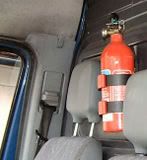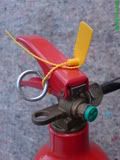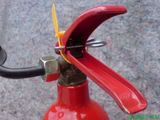Sorry to correct you robB39, but some of what you’ve put is possibly a little misleading.
robB39:
Hazardous goods require a DGN (Dangerous Goods Note) for shipping/rail company. If you are carrying flammable it must have the flash point on also.
IMDG requires the flashpoint to be declared only if the flashpoint is below 60 deg. C.
The flashpoint isn’t required by the rail Regs (RID.)
IMDG and RID are completely separate sets of Regs, and lumping them together can only lead to confusion IMHO. 
Eg. neither IMDG nor RID have a requirement for Tremcards, whereas ADR does, but only once there’s more than a certain amount of dangerous goods on board.
robB39:
You also need your information in writing (TREM card) you must have copies in the language of the driver and the language of every country you are transiting.
But only if the load exceeds the relevant ADR threshold limit.
If it does then the info you gave is correct, but you’d also need IIWs for the languages of the country of origin and the country of destination.
robB39:
When transiting Belgium you will need one copy French and one copy in Dutch.
ADR clearly allows for this to be the case, but I’ve no idea as to whether the Belgian Competent Authority requires it.
robB39:
You will need to place hazard warning stickers (diamonds) on trailer for shipping.
You can carry your own or the shipping company will supply them; for a fee.
That might be problematic sometimes, since you’d also need a UN number on or next to the placards for shipments of the same “stuff” in excess of 4,000kgs under the IMDG Code. That’s not a bad idea though, because you’d only have to buy the “half height” panels with UN numbers on when you exceed 4,000kgs, which probably wouldn’t be every trip.
Here’s a powerpoint slide from my IMDG stuff: (No copyright issues here.  )
)

robB39:
I’m editing to add. ADR Europe requires that you have two flashing beacons for front and rear of vehicle, and they must work. Take appropriate batteries but do not put in lamp until needed that way they will stay fresh.
Taking this as you’ve worded it, it would leave drivers thinking that they need flashing beacons when carrying an ADR regulated load,
which isn’t quite true as they’re only an OPTION…
What ADR actually requires is “two self-standing warning signs” which may be reflective cones or triangles OR flashing amber lights. IMHO, two triangles is the easiest option by far, because they take only a little space and don’t rely on batteries. BTW, if the orange flashing lights option is used, the lights MUST be independant of the vehicle’s electrical system.
Since we’re on the subject of ADR, we shouldn’t forget our wheel chocks (2 for an artic or wag and drag, and 1 for a rigid) which must be suitable for the weight of the vehicle and the diameter of the wheels. There’s also a requirement for a pocket lamp and a hi-viz for each member of the vehicle crew. In some cases, a respiratory protective device is also required.
To develop this list a little further:
As from 01/01/08, the requirements for fire extinguishers are:
Carriage in Limited Quantities. (Per individual package)
IF you’re carrying Limited Quantities (LQs) you don’t need any extinguishers.
IF you carry LQs with extinguishers on board, then that’s OK, since you’d have more than the minimum of nil. 
Carriage below threshold. (= total weight/literage of all packages on vehicle not exempted by LQs)
IF you’re carrying a load that’s NOT packaged in LQs, but below the threshold, then you’ll need:
1 X 2kg (usually) dry powder extinguisher suitable for fighting a fire in the engine or the cab of the vehicle.
Something like this:
 or this
or this 
In larger vehicles than those shown in the pics, the 2kg extinguisher can be mounted on the framework below the driver’s seat.
Carriage in excess of ADR threshold ( ie, when ADR applies in full)
You’ll need the 2kg extinguisher as above, PLUS one more extinguisher depending on the permitted G.V.W. of your vehicle as follows:
(The actual weight of goods that you’re carrying is irrelevant here  )
)
Permitted G.V.W. less than 3,500 kgs needs ANOTHER 2kg extinguisher as above, making a total of 4kgs.
Permitted G.V.W. between 3,500kgs and less than 7,500kgs needs ANOTHER 6kg extinguisher making a total of 8kgs
Permitted G.V.W over 7,500kgs ie ANY LGV needs ANOTHER 10kg extinguisher making a total of 12kgs
Once the vehicle is an LGV, it doesn’t matter whether it’s a rigid, wag and drag or an artic 
My suggestion for ADR compliance for LGVs is to consider having extinguishers of the following sizes: 2kg + 6kg + 6kg = 14kg. With the minimum requirement being 12kgs for an LGV, there’s no problem in being 2 kg to the good. The 6kg extinguishers are quite plentiful and 2 of them might work out cheaper than a single 10kg extinguisher.
 Remember, 12kg is a minimum, not a maximum.
Remember, 12kg is a minimum, not a maximum. 
On most vehicles, the larger of the extinguishers is carried outside the vehicle in some kind of protective covering,
something like this:

Other requirements:
-
Extinguishers must be of an approved type ie. bear the CE mark.
-
Extinguishers must be periodically inspected and bear a label / sticker showing the next due date of inspection
-
Extinguishers must be fitted with a seal AND pin
Something like this:


-
Extinguishers must be protected from the effects of the weather.
-
Extinguishers must be easily accessible.
In the event that 1 and 2 and 3 above aren’t complied with, you’ll be done for not having an extinguisher.
If that little lot weren’t enough, there’s ALSO an ADR requirement that all items of PPE and intervention equipment as specified on the IIWs are on board the vehicle.
As usual, quotes are available upon request.

 or this
or this 


